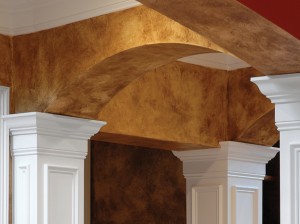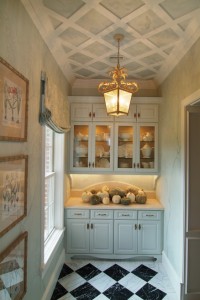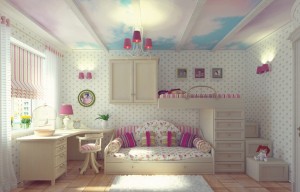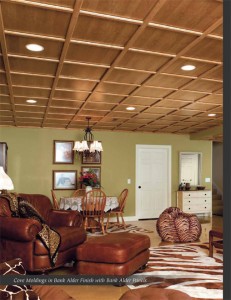Look Up: Creative Ceiling Treatments Earn High Marks
 We spend hours sorting through paint swatches for our walls, and then more hours choosing the best flooring. But what about our ceilings? Are there just as many options for this additional “wall”? From choosing a complementary paint color, to adding texture effects, to exploring alternative coverings, you may find that the view above could become your favorite view of all.
We spend hours sorting through paint swatches for our walls, and then more hours choosing the best flooring. But what about our ceilings? Are there just as many options for this additional “wall”? From choosing a complementary paint color, to adding texture effects, to exploring alternative coverings, you may find that the view above could become your favorite view of all.
Color it Up
One of the quickest, easiest, and most budget-friendly ways to liven up a room is to paint the ceiling. Isn’t it ironic that many of us settle for plain white ceilings throughout our house, while we will go to all lengths to find the right color for our walls? The fact is that the ceiling color can add that perfect finishing touch to your room. Experts usually recommend staying within the hues of your wall color for your ceiling, using slightly darker shades for smaller rooms or slightly lighter for larger rooms. Lighter, neutral shades can make a ceiling appear higher, while darker shades can make a room feel cozier. A room with all-white walls and light-colored flooring could benefit from a more vibrant color for the ceiling. If you have a particular ceiling fan or light fixture you’d like to draw focus to, consider painting the ceiling red, gray, or chocolate brown. The idea is for the eye to be able to make a smooth transition from the floor to ceiling, no matter the shades.
Sometimes experimenting with a new finish on a plain white ceiling is all you need to give your room a new look. Although many paint manufacturers offer ultra-flat ceiling paint (which will reflect light and hide imperfections, and is specially formulated for less splatter), consider a high-gloss coat to shine things up. In a bathroom, for instance, a glossy white ceiling can create a mirror effect and make the whole room seem bigger and brighter. In a young girl’s bedroom, consider using a “glitter effect” topcoat for the ceiling (made by many of the top paint brands) to bring sparkle and magic into her world. Paint that comes in metallic finishes can also fit your fancy in other rooms; add a high-gloss glaze over it, and your dining room ceiling could shine like the silver on the table below.
 Brush it Up
Brush it Up
A textured ceiling can add a bit of personality to a room, but it can also cover imperfections, stains and cracks.
Popcorn ceilings were popular a few decades ago (and if you own an older home, odds are you may have this style in many of your rooms), but there are more painting techniques that can add character to a room. You can “sponge,” “smoosh,” “stomp,” “stipple,” or “strié” your ceiling for a dramatic effect. That’s a lot of silly sounding “s” words, but these techniques each call for rolling a rag or other material on the paint, or using a glaze with different brushes and different strokes. Of course, these effects take even more care when you’re doing them overhead. Cover the floor and all furniture with drop cloths, and wear protective eyewear. While you could climb a ladder to sponge or stipple in small areas at a time, you can also use special rollers with your feet firmly planted on the ground. For a great strie effect, try using a whisk broom.
There are also paints that will add immediate texture to a wall, as they are infused with small, sandy particles that can create a three-dimensional effect; no need for a special spray gun or sponge to create the look of plaster or stucco. These paints come in an assortment of colors.
 Cover It Up
Cover It Up
There are plenty of solutions for ceiling treatments that don’t come in a can. Create a one-of-a-kind design by using wallpaper, tiles, or even fabric coverings.
Your home may not be the Sistine Chapel, but adding masterpieces to the ceiling will instantly cause your guests to look up in awe. One way of bringing art to the top is using wallpaper. Browsing wallpaper is like going to an art gallery; there are so many patterns and murals, with some just screaming to end up on a ceiling. Think baby blue sky with clouds for a nursery, florals for a sunroom, a sophisticated geometric to highlight a chandelier in the dining room…the options are endless. Wallpaper can be as easy to install on the ceiling as it is on the wall, although it is usually a two-person job.
If you have a drop (suspended) ceiling, a fun project could be decorating the panels one by one for a whole new look, especially if you harbor some artistic talent yourself. You can remove the panels, decorate them the way you like, then place them back (no straining your neck looking upward for so long!). Try painting the panels with textured paint or metallic finishes, or use two different colors for a checkerboard effect. Consider using wallpaper or fabric and your options expand even more. (Create a tufted look with fabric by stapling a fabric square in the center and covering the staple with a button, tucking the fabric loosely around the back.)
Even the most upscale ceiling designs can be achieved by using creative coverings, such as tin tiles and leafing with precious metals. Ornate tin tiles, offered in nickel, bronze, and copper, among other metals, can give your rooms an Old-World style. Tiles are relatively low in cost and affix easily to the existing ceiling either by adhesives or by nails, which are built into the design. Pair tin ceiling tiles with coordinating backsplashes and you could change the whole look of your kitchen or dining room.
 Gilding your ceiling with any of a number of precious metal-looking leafing products can also create a luxury look. Leafing comes on rolls (called ribbon leafing) and can be applied fairly quickly.
Gilding your ceiling with any of a number of precious metal-looking leafing products can also create a luxury look. Leafing comes on rolls (called ribbon leafing) and can be applied fairly quickly.
For a more contemporary look, choose wood ceiling planks, which also fall into the easy-to-install category. Ceiling products like WoodTrac by Sauder (www.woodtrac.com) can be mounted onto an existing suspended ceiling grid or directly to the wall. Clips attach to the grid or the ceiling itself and molding is slid on. The ceiling planks fit easily into grooves in the molding. Wood finishes range from bamboo to oak to cherry, so you can coordinate with your furnishings and flooring for a cohesive, natural look.
For ceilings with exposed beams, experiment with different stains and paint. Or for those without, add some rustic faux beams. For a contemporary, sleek look, attach metal beams to the ceiling and paint them the same color as the ceiling, or even a contrasting color.
As with any home project, make your ceilings reflect your style. Don’t be afraid of giving your ceiling a new look. We spend more time than you think looking up at our ceilings—as we lie in bed, do curl-ups, or daydream on the couch. Raising this oft-forgotten space to the top of your list will surely take your room’s design to new heights.
Guilded Ceiling, Smoosh, Stipple, Stomp, Suspended Ceilings, Textured Ceilings, WoodTrac by Sauder






